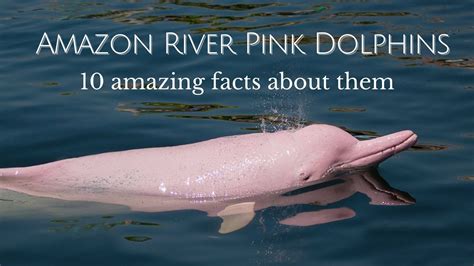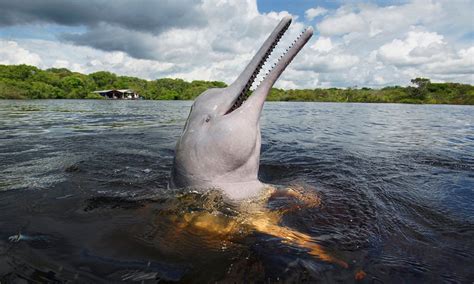Amazon River Dolphin

The Amazon River Dolphin, also known as the Pink River Dolphin or Boto, is a freshwater dolphin species found in the rivers and streams of the Amazon and Orinoco river basins in South America. Reaching lengths of up to 2.5 meters (8.2 feet) and weighing up to 250 kilograms (550 pounds), it is one of the largest freshwater dolphins in the world. The species is known for its distinctive pink color, which can vary in intensity from a pale pink to a deep magenta, and its ability to thrive in the complex and dynamic aquatic environment of the Amazon river system.
Despite its adaptability, the Amazon River Dolphin is facing numerous threats, including habitat loss and degradation, entanglement in fishing nets, and hunting for its meat and blubber. Conservation efforts are underway to protect the species and its habitat, including the establishment of protected areas and education programs for local communities. However, more research is needed to fully understand the ecological and behavioral characteristics of the Amazon River Dolphin and to develop effective conservation strategies. With its unique appearance and intriguing behavior, the Amazon River Dolphin has become an iconic symbol of the Amazon river system and a priority species for conservation efforts.
Key Points
- The Amazon River Dolphin is a freshwater dolphin species found in the Amazon and Orinoco river basins in South America.
- It can reach lengths of up to 2.5 meters (8.2 feet) and weigh up to 250 kilograms (550 pounds), making it one of the largest freshwater dolphins in the world.
- The species is known for its distinctive pink color, which can vary in intensity from a pale pink to a deep magenta.
- Amazon River Dolphins are facing numerous threats, including habitat loss and degradation, entanglement in fishing nets, and hunting for its meat and blubber.
- Conservation efforts are underway to protect the species and its habitat, including the establishment of protected areas and education programs for local communities.
Habitat and Distribution

The Amazon River Dolphin is found in the freshwater rivers and streams of the Amazon and Orinoco river basins in South America, including countries such as Brazil, Peru, Colombia, and Venezuela. The species is widely distributed throughout the Amazon river system, from the Andean foothills to the Amazon River delta, and can be found in a variety of aquatic habitats, including rivers, streams, and flooded forests. The dolphins are adapted to the dynamic and complex environment of the Amazon river system, where the water level and flow can vary significantly over the course of the year.
Physical Characteristics
The Amazon River Dolphin has a number of distinctive physical characteristics, including its pink color, which can vary in intensity from a pale pink to a deep magenta. The dolphins have a robust body, with a rounded forehead and a prominent melon, and can reach lengths of up to 2.5 meters (8.2 feet) and weigh up to 250 kilograms (550 pounds). The species also has a number of adaptations that allow it to thrive in the freshwater environment of the Amazon river system, including a flexible body and a powerful tail that allows it to navigate the complex network of rivers and streams.
| Physical Characteristic | Value |
|---|---|
| Length | Up to 2.5 meters (8.2 feet) |
| Weight | Up to 250 kilograms (550 pounds) |
| Color | Pink, varying in intensity from pale pink to deep magenta |
| Body Shape | Robust, with rounded forehead and prominent melon |

Behavior and Diet

Amazon River Dolphins are social animals and are often found in small groups of up to 10 individuals. The dolphins are carnivores and feed on a variety of fish, crustaceans, and other aquatic animals. They have a number of adaptations that allow them to catch their prey in the complex and dynamic environment of the Amazon river system, including a flexible body and a powerful tail that allows them to navigate the network of rivers and streams. The dolphins are also known to use a variety of hunting strategies, including ambushing and cornering their prey.
Conservation Status
The Amazon River Dolphin is listed as Vulnerable on the IUCN Red List, due to a number of threats, including habitat loss and degradation, entanglement in fishing nets, and hunting for its meat and blubber. Conservation efforts are underway to protect the species and its habitat, including the establishment of protected areas and education programs for local communities. However, more research is needed to fully understand the ecological and behavioral characteristics of the Amazon River Dolphin and to develop effective conservation strategies.
What is the main threat to the Amazon River Dolphin population?
+The main threat to the Amazon River Dolphin population is habitat loss and degradation, due to deforestation and the construction of dams and other infrastructure projects.
What is being done to conserve the Amazon River Dolphin?
+Conservation efforts are underway to protect the Amazon River Dolphin and its habitat, including the establishment of protected areas and education programs for local communities.
How can I help to protect the Amazon River Dolphin?
+You can help to protect the Amazon River Dolphin by supporting conservation efforts and spreading awareness about the importance of protecting the species and its habitat.
In conclusion, the Amazon River Dolphin is a unique and fascinating species that is found in the freshwater rivers and streams of the Amazon and Orinoco river basins in South America. The species is facing numerous threats, including habitat loss and degradation, entanglement in fishing nets, and hunting for its meat and blubber. Conservation efforts are underway to protect the species and its habitat, but more research is needed to fully understand the ecological and behavioral characteristics of the Amazon River Dolphin and to develop effective conservation strategies.



